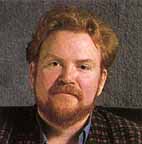Comparing Stereo Recorders |
|
|
Comparing Stereo Recorders |
|
|
 |
BRIAN MASTERSON PREFERRED CHOICE : STUDER DASH |
Was it a valid exercise ?
The biggest problem I had was that I was comparing five formats against each other and not to the live reference. I would have to say that good as all the formats were, from what I remembered, none of them came 10 out of 10 to the live reference. I would dearly have loved a situation, and I know it would be harder to organise, where I could have been able to switch back and forth to the live source and keep my point of reference. Otherwise I would say that it was a very valid exercise. It was a fantastic opportunity, which I think very few studio engineers would ever have, to evaluate five top of the range machines. The differences for me were small in four cases ; there was one that I felt quite strongly that I didn't like. The one that I marked as first was perhaps 10 or 15 % above the others. I marked D (Studer DASH) as first and E (Mitsubishi) as last. I felt A (Studer + Dolby SR) and C (Otari + Dolby SR) were analogue.
They were. A was the Studer analogue with Dolby SR and C was the Otari with SR. D was the Studer DASH and E the Mitsubishi.
I'm pleased I got that much right. I felt that A and C were analogue and of them I slightly preferred C over A. Having decided that, I thought that if I'm right, the remainder are all digital machines - and of those one of them is my favourite, i.e. D, and one of them is my least favourite - E. Can this be true ? There was such a difference. And even now that you've told me what they were I'll still stick to my guns because I feel quite strongly that I didn't like E. And very strongly that I did like D. Interesting.
What were you listening for ?
I was listening for what I call openness. If you look at my notes I said things like 'slightly backward' because what I was listening for was that there was nothing between what I heard in the live and the recorded formats.
I don't think any of the systems betrayed any problems with signal to noise but I talked to the engineer and said that I had detected some clipping on the piano when the band were playing live and I also heard this on playback and he confirmed to me that he thought there was some clipping coming off the floor. I can't say that I heard any wow or flutter but I feel that's how I detected the analogue machines. That and the warmth that people talk about. I marked machine E (Mitsubishi) as aggressive, A and C I marked as slightly regressive. I felt machine E would have lined up within about 1/2dB from 20 to 20kHz but that didn't stop it sounding aggressive to me.
Another thing I feel I must say is that
I don't think recording engineers normally listen in the way they were asked to listen
today. My function as a recording engineer is related almost exclusively to musicality,
and although our ears should be trained I believe they're trained in a different
way.
Are you surprised by your choice of format ?
I've never worked with the Studer DASH or the Mitsubishi. I have a great fondness for Windmill Lane's Studer A820 with Dolby SR and until now I've never heard anything better than that. Now, obviously, I would love to be able to afford a Studer DASH. So yes and no - I am surprised and I'm not surprised.
A lot of people talk about this certain analogue magic and I think it's got it for certain types of music and not for others. I think the choice of music was good in that I tend to specialise in acoustic music so for me a jazz quartet is fairly close, but certain rock engineers would perhaps prefer the analogue for what it does to their music.
The sonic quality of a format is only one of a whole spectrum of things you have to take into consideration when looking for a machine.
That's true. If the studio world was appreciated by its clients in terms of studio rates, etc, then I would say let's go for the best format irrespective of how easy it is to edit on. Analogue editing is something I enjoy doing and I couldn't bear to go through the task of electronic editing iust to see if one section will edit onto another. However, there are some edits that you can do electronically that you could never do on tape.
How will this test change your approach in the future ?
Until now I thought I had the best in Studer A820 with Dolby SR but the increase in sonic performance of the Studer DASH is not great enough to make me rush out and buy one. It's also quite useless to me because there are no CD plants that would accept a tape off a Studer DASH machine, so I'd have to transfer to 1630. So my life is not going to change. However, if I was to buy a DASH machine then I'd buy the Studer even if it were two or three thousand pounds more.
In conclusion then ?
Quite honestly I was surprised at the machine I didn't like - machine E (Mitsubishi). Four machines were pretty close but with E I thought 'Gosh, I really don't like this at all. For a machine that costs as much as it does I'm not happy with what I'm hearing because it's changing the music a lot.' That was the big surprise.
The magazine is to be complimented on
this idea because this sort of test is what we need. There is so much bullshit talked
in hifi magazines about putting amps on bricks and the like and you get people making
some very strong statements. What this afternoon has proved is that the differences
are not that great but what it's also proved is that there are some !
|
Studer + Dolby SR |
Sony DASH |
Otari + Dolby SR |
Studer DASH |
Mitsubishi ProDigi |
|
| Format |
A |
B |
C |
D |
E |
| Preference |
3rd |
4th |
2nd |
1st |
5th |
 |
MIKE HEDGES PREFERRED CHOICE : STUDER analogue with DOLBY SR and MITSUBISHI ProDigi |
Was it interesting ?
Yes, but you'd expect all the machines
to sound good. The bass response on a couple of them (C: Otari + SR and D: Studer
DASH) was definitely down but without hearing the original ... when you're talking
about down you're talking about a miniscule amount.
What do you master on ?
DAT or 1/2inch because you can edit it.
Half inch analogue with SR gives you easy editing plus you can turn the tape over
and run backwards, that sort of thing. Having said that, there is a difference in
quality between 15 and 30 ips.
Which format did you prefer ?
I liked A (Studer + Dolby SR) and E (Mitsubishi). Whether or not they were most
like the original I couldn't really say.
|
Studer + Dolby SR |
Sony DASH |
Otari + Dolby SR |
Studer DASH |
Mitsubishi ProDigi |
|
| Format |
A |
B |
C |
D |
E |
| Preference |
1st |
3rd |
3rd |
2nd |
1st |
|
|